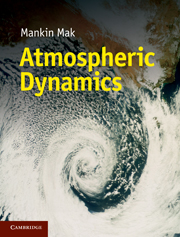Book contents
- Frontmatter
- Contents
- Preface
- 1 Fundamental concepts and physical laws
- 2 Basic approximations and elementary flows
- 3 Vorticity and potential vorticity dynamics
- 4 Friction and boundary layers
- 5 Fundamentals of wave dynamics
- 6 Quasi-geostrophic theory and two-layer model
- 7 Dynamic adjustment
- 8 Instability theories
- 9 Stationary planetary wave dynamics
- 10 Wave-mean flow interaction
- 11 Equilibration dynamics of baroclinic waves
- 12 Nongeostrophic dynamics
- Appendix: Mathematical tools
- References
- Index
- Plate section
2 - Basic approximations and elementary flows
Published online by Cambridge University Press: 05 June 2012
- Frontmatter
- Contents
- Preface
- 1 Fundamental concepts and physical laws
- 2 Basic approximations and elementary flows
- 3 Vorticity and potential vorticity dynamics
- 4 Friction and boundary layers
- 5 Fundamentals of wave dynamics
- 6 Quasi-geostrophic theory and two-layer model
- 7 Dynamic adjustment
- 8 Instability theories
- 9 Stationary planetary wave dynamics
- 10 Wave-mean flow interaction
- 11 Equilibration dynamics of baroclinic waves
- 12 Nongeostrophic dynamics
- Appendix: Mathematical tools
- References
- Index
- Plate section
Summary
It would not have been possible to make progress in atmospheric sciences if researchers had not been innovative in introducing various types of approximations in their analyses. Approximations enabled them to investigate the dynamical nature of qualitatively different types of disturbances separately. Approximations are therefore both necessary and valuable. They must rest upon observational information. In this chapter, we will discuss some rudimentary approximations and their implications. We will also show how to transform the governing equations from using height as a vertical coordinate to using either pressure or potential temperature as a vertical coordinate. The dynamics of some simple balanced flows as well as the kinematic properties of a flow in general will be discussed.
Sphericity of the Earth and thin-atmosphere approximation
The most elementary approximations are related to the physical characteristics of the planet Earth. The Earth is a planet rapidly rotating about an axis through the north and south poles once every 24 hours. It also slowly rotates around the Sun once every 365 days. Its axis tilts at an angle of ~ 23° relative to the plane of rotation about the Sun. The duration of solar radiation reaching each location on Earth therefore varies throughout a year. This gives rise to four seasons. The Earth is an ellipsoid. Its equatorial radius is only 7.1 km longer than its mean radius (6371 km) and its polar radius is about 14.2 km shorter.
- Type
- Chapter
- Information
- Atmospheric Dynamics , pp. 27 - 54Publisher: Cambridge University PressPrint publication year: 2011



